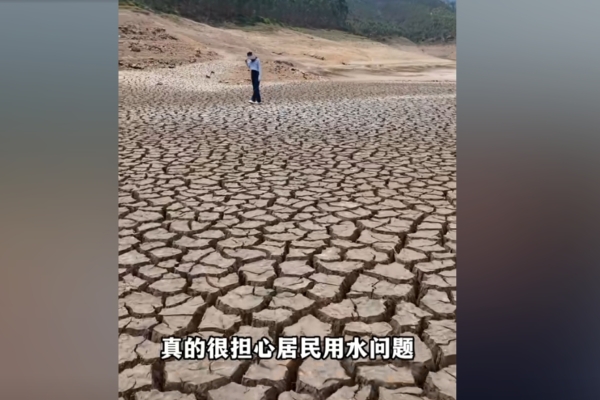Recently, severe drought continues to affect multiple areas in Guangxi, China. The foundation of the bridge in Chongzuo is exposed due to the drought, with interviewees noting that related videos have been deleted. The official response is contradictory, as authorities both dismiss urgent pleas for rain in videos from local farmers as “rumors” while acknowledging the actual drought situation, leaving observers puzzled.
According to local reports on April 28th, in Chongzuo, Guangxi, the water level of the left branch of the Chongzuo section of the river has significantly decreased due to the drought, causing the foundation of the Chongzuo Bridge to be exposed and a large area of the river beach near the famous “Left River Leaning Tower” to be uncovered.
The Department of Water Resources of the Guangxi Zhuang Autonomous Region stated that since November 2024, the average precipitation in the entire Guangxi region has been nearly 70 percent below normal levels, the lowest for the same period since 1961. This has led to drought conditions in many parts of Guangxi, with some areas experiencing extreme drought. According to the Guangxi Zhuang Autonomous Region Flood Control and Drought Relief Headquarters, data from April 17th shows that 97.5% of Guangxi is experiencing meteorological drought, with 68.7% in an extreme drought situation.
Recently, a resident of Nanning, Guangxi, named Zhao Yong, expressed to the press that in his fifty-plus years of life, he has never seen such a severe drought. “No rain this year, no rain last year either. Without water, trees do not bloom, and bees have no flowers to gather from.”
He mentioned that the water in small rivers in rural areas of Guangxi has dried up, leaving farmers solely reliant on the weather. If there is no rainfall, there is nothing they can do.
Zhao Yong pointed out that most areas in Guangxi are facing drought. The drought has had a significant impact on rice and sugarcane cultivation in Guangxi. “The sugarcane is dying. Even if it hasn’t completely withered, it’s close to death. Some people plant late-season rice, waiting until July or August to transplant; others grow early-season rice, transplanting around Qingming Festival, but due to the drought and lack of water, it’s still not working.”
Another Nanning resident, Sun Wen, revealed to the press that his family in Beibu, Guangxi, grows a large amount of sugarcane. This year’s drought is severe, with the sugarcane on the verge of perishing, causing significant losses.
He said that without rain, farmers are trying to water their fields themselves, but their efforts are limited.
Beibu City is a prefecture-level city under the jurisdiction of the Guangxi Zhuang Autonomous Region, located in central Guangxi, bordered by other prefecture-level cities such as Nanning, Hechi, Liuzhou, Guilin, Wuzhou, and Guigang.
Recently, Guangxi has experienced three rounds of rainfall, easing the meteorological drought to varying degrees in different areas. However, due to uneven rainfall distribution, some regions are still severely affected by the meteorological drought.
The Guangxi Department of Agriculture and Rural Affairs released the “Guangxi Soil Moisture Briefing 2025 Issue 8” on April 29th, indicating that the dry areas with heavy precipitation deficiency will persist in the upcoming week.
Previously, media coverage on the severe drought in Guangxi has been scarce. It is reported that drought has affected 11 cities and 52 counties or districts, with estimated economic losses reaching 210 million RMB.
91-year-old Mrs. Yang from Guigang, Guangxi, expressed that she has never witnessed such severe drought in the past decades.
The ongoing drought in Guangxi has left farmers in dire straits, prompting a surge of videos pleading for rain on social media platforms. Authorities quickly debunked these rain-plea scenes as staged but admitted the actual drought situation.
The conflicting official response to the drought situation in terms of information dissemination has raised doubts.
Sun Wen, the aforementioned resident of Nanning, mentioned the lack of news coverage on the drought and the government’s inadequate assistance in resolving farmers’ difficulties. “I posted videos about the drought online, and they were deleted.”

